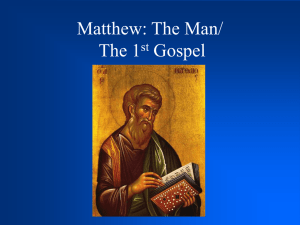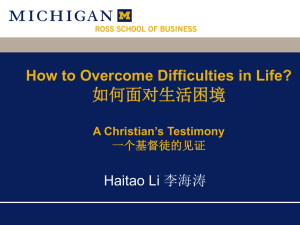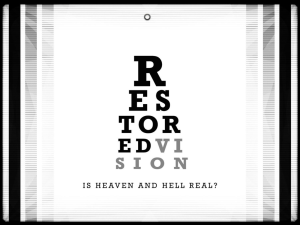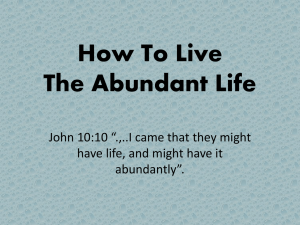Matthew Effect - The George Washington University
advertisement
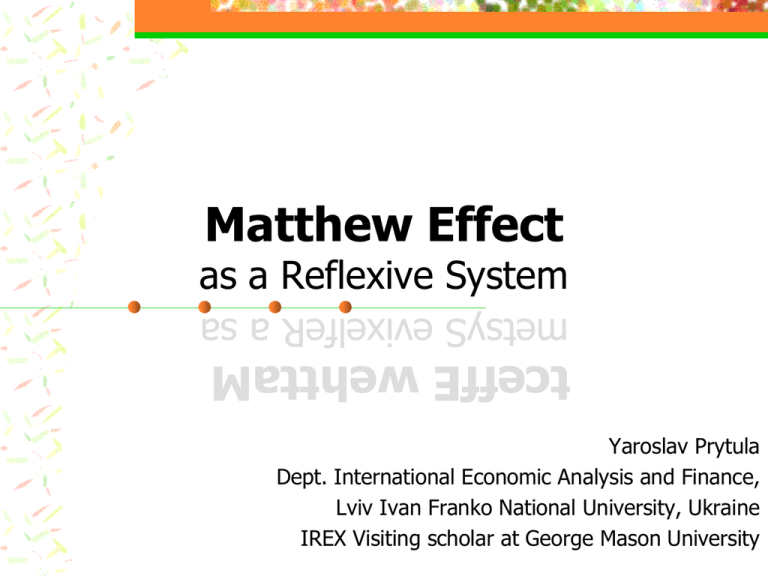
Matthew Effect as a Reflexive System metsyS evixelfeR a sa tceffE wehttaM Yaroslav Prytula Dept. International Economic Analysis and Finance, Lviv Ivan Franko National University, Ukraine IREX Visiting scholar at George Mason University Outline What is the Matthew Effect? Evidences and logic of the Matthew Effect Modelling of the Matthew Effect Is the Matthew Effect a natural law? Self-fulfilling prophesy Reflexivity and the Matthew Effect Ukrainian proverb + Poor Fool + Matthew Effect Robert K. Merton: the phenomenon when “the rich get richer and the poor get poorer” Other words – this is the phenomenon of accumulated advantages. Although originally developed by Merton to explain advancement in scientific careers, cumulative advantage is a general mechanism for inequality across any temporal process in which a favorable relative position becomes a resource that produces further relative gains. (DiPrete and Eirich, 2006) Saint Matthew’s Gospel (25:29): For unto every one that hath shall be given, and he shall have abundance: but from him that hath not shall be taken away even that which he hath Matthew Effect in science and research Newton, Leibniz and calculus. ‘Nobel prize’ effect (Zuckerman 1972, Merton 1988): ”the world Brain drain effect (Schott 1998) is peculiar in this matter of how it gives credit. It tends to give the credit to already famous people.” ‘Harvard’ effect (Medoff, 2006): “Ceteris paribus, an article written by an economist affiliated with Harvard University or the University of Chicago had significantly (statistically and numerically) greater peer recognition than if it was written by an economist affiliated with a less prestigious university.” Matilda effect (Rossiter 1993, 1995): “an effect in science that has historically promoted cumulative male advantage and female disadvantage through the operation of old-boy networks and other discriminatory practices.” Matthew Effect in technology QWERTY effect ‘Increasing returns’ (Arthur 1996): product gains value with every additional unit produced. ‘Winner take all’ effect (Schiller 2004): current information technologies may produce winner-take-all effect. No limit to the size of technological gap Matthew Effect in economic Hysteresis in unemployment (Heckman & Borjas 1980): previous unemployment creates future unemployment. Compensation/bonuses for top managers (Frank & Cook, 1996): in 1974 the average CEO’s compensation of a large US company was 35 times higher then the compensation of average manufacture worker, in became 120 times higher in 1990s, 500 – in 2000 and reached 1000 in mid 2000 declining after 2007-08 criticism. Flat or progressive tax rate, Flat or regressive taxes lead to redistribution of wealth to upper income groups creating ME, at the same time progressive taxation often lead to tax avoidance or tax evasion and also may create ME. Wealth accumulation, compound interest rate. Wealth accumulation, power of compounding Difference in investing $100 and $1000 for 50 years with 5% compounding interest rate. 12000 10000 8000 6000 4000 2000 48 45 42 39 36 33 30 27 24 21 18 15 12 9 6 3 0 0 Matthew Effect in health Health accumulation The Status Syndrome (Marmot 2008): our social standing directly affects our health and life expectancy. Socio-economic position is an important determinant for health outcomes. Marmot argues that we should make our society more participatory and inclusive in order to increase overall public health. Matthew Effect in education Reading ability (Stanovich 1986) “slow reading acquisition has cognitive, behavioral, and motivational consequences that slow the development of other cognitive skills and inhibit performance on many academic tasks” Skills beget skills (Heckman 2006) “Skill begets skill. Motivation begets motivation. If a child is not motivated and stimulated to learn and engage early on in life, the more likely it is that when the child becomes an adult, it will fail in social and economic life” Matthew Effect in sports Confusion of ability with maturity (Gladwell 2008) Soccer clubs like superstar universities Source: www.sportsscientists.com/2009/01/mattheweffect.html Matthew Effect in Life Monopoly game Winner take all Too big to fail Economy of scale Migration patterns Bank run Urban population growth Use of English language Use of limited number of words for communication: Zipf’s law Opportunity structures Opportunities are not randomly distributed Merton defines opportunity structures as “the scale and distribution of conditions that provide various probabilities for acting individuals and groups to achieve specifiable outcomes” and “the interacting processes of individual self-selection and institutional social selection affect successive probabilities of access to the opportunity structure” Example: time and place are important (Gladwell 2008): Out of 75 riches people in human history 14 were born during 9 years of Industrial revolution Another example: oligarchs in Russia and Ukraine Picture of Ukrainian oligarch Male Average age – 47 years Higher education Place of doing business: Kyiv (40%), Eastern Ukraine (52%) Picture of Russian oligarch Male Lives in Moscow Average age – 50 years Ecclesiastes, 9:11 I have seen something else under the sun: The race is not to the swift or the battle to the strong, nor does food come to the wise or wealth to the brilliant or favor to the learned; but time and chance happen to them all. Other names for the Matthew Effect Cumulative advantages Path-dependent increasing returns First-mover advantage Positive feedback loop Success breeds success Multiplier effect Gibrat's rule of proportionate growth Lock-in Halo effect Self-fulfilling prophecy Preferential attachment Merton’s Matthew Effect and Myrdal’s circular causation Myrdal (1944) provides very similar analysis of cumulative (dis)advantage (circular causation) to Merton works. While Merton was inclined to ascribe to social systems a natural tendency toward stable equilibrium, Myrdal was rather skeptical of the existence of natural equilibrium of any kind (Rigney 2010). Myrdal points out that dynamism and instability are the natural order of things in economics and other social systems: “circular causation has validity over the entire field of social relations. It should be main hypothesis when studying economic underdevelopment and development” The last proposition is quite similar to Soros’s (1987) concept of reflexivity in social systems. Analytical formulation of Matthew Effect Usually ME is modeled as a differential equation of exponential growth, i.e. that implies or in discrete case Analytical formulation of Matthew Effect Adding possible exogenous influence X and stochastic term e: Merton argued that previous success does not directly cause current success, but it rather increases one’s level of resources that (in combination with other factors) increases current success, i.e. Analytical formulation of Matthew Effect Combining last two equations gives us: That is the same as previous representation. Adding varying we can derive evidence consistent equation with growing level of inequality over time. Merton vs. Mincer Mincre’s human capital earning equation: States that shock has temporary effect while in Merton cumulative advantage model it has long-lasting effect. Merton vs. Dickens & Flynn social-multiplier effects Dickens and Flynn proposed a sophisticated explanation for the considerable rise in measured IQ between the early 1950s and the early 1980s in the Netherlands and nearly 20 other countries. They show that the social-multiplier effects (link between IQ and the local environment) in their model allow relatively small exogenous changes in the environment to cause surprisingly large changes over time in a population’s mean IQ. Their model is, essentially: What limits the Matthew Effect? Merton (1968, 1988): Limit of resources or capacity to expand External factor, government interventions (redistribution) ME will always fail to unfold in communication systems fraught with extreme noise Morality, altruism Reflexivity What reins in the Matthew Effect? Podolny’s (1993) points out that status-erosion occurs as the consequence of a high-status organization’s choice to expand in market share by encroaching on a lower-status competitor’s niche. What reins in the Matthew Effect? In their article “When Do Matthew Effects Occur?” Bothner et al. built a model of status-based competition in which actors always experience the Matthew Effect at the micro level. They studied what happens on macro level. Their findings reveal the importance of a single factor governing whether the Matthew Effect operates freely or is circumscribed. This factor is the degree to which status diffuses through social relations. When actors’ status levels are strongly influenced by the status levels of those dispensing recognition to them (i.e., status diffusion occurs), then in due course the top-ranked actor is nearly matched in status by the actor she endorses, i.e. no ME. What reins in the Matthew Effect? A case of status diffusion, is in the well-known account of Baron de Rothschild’s endorsement of a friend who requested a loan: “Reputedly, the great man replied, ‘I won’t give you a loan myself; but I will walk arm-in-arm with you across the floor of the Stock Exchange, and you soon shall have willing lenders to spare”’ (Caldini, 1989). Is Matthew Effect a natural law? Sloman and Dunham (2004): ME usually is present in biological competition within species. Arthur (1996) New business environment makes increasing returns model (namely ME) more and more applicable. Myrdal (1944): circular causation has validity over the entire field of social relations. It should be main hypothesis when studying economic underdevelopment and development Dannafer and Gannon (2005): ME is sufficiently pervasive, obdurate and irrepressible social tendency as to be considered a sociological law. Taleb (2007) criticised the “naivety” of the Matthew Effect by pointing out that it can not explain the decline of civilizations. Self-fulfilling prophecy and Matthew Effect A prediction that directly or indirectly causes itself to become true. Merton: “The self-fulfilling prophecy is, in the beginning, a false definition of the situation evoking a new behaviour which makes the original false conception come 'true'.” Thomas theorem (1928):”if men define situations as real, they are real in their consequences” Keynes’s Beauty Contest Theory (1936) Goodhart's law (1975): once a social or economic indicator or other surrogate measure is made a target for the purpose of conducting social or economic policy, then it will lose the information content that would qualify it to play such a role. Examples in finance, consumer behavior, voting. Self-fulfilling prophecy and economist profession Raghuram Rajan (Chicago Univ.) on causes of recent crisis: Could it be corruption? Some academic economists consult for banks or rating agencies, give speeches to investor conferences, serve as expert witnesses, and carry out sponsored research. It would be natural to suspect us of bias. The bias could be implicit: our worldview is shaped by what our friends in industry believe. Or it may be an explicit bias: an economist might write a report that is influenced by what a sponsor wants to hear, or give testimony that is purely mercenary. Source: www.project-syndicate.org/commentary/rajan14/English Reflexivity Reflexivity = An act of self-reference or self-feedback. Soros (1987): the biases of individuals enter into market transactions, potentially changing the perception of fundamentals of the economy. Umpleby (2007): Reflexivity occurs in social systems when an actor observes and thinks about his or her actions and their consequences and then modifies his or her behavior Sourse: Umpleby 2007 Reflexivity and Matthew Effect Matthew Effect may be a feedback mechanism of observation into observation, like, compounding interest rate. Matthew Effect may be a feedback of observer to observer’s social group back to observer, like social-multiplier effect. Also, Matthew Effect may be a feedback of observation to observer to observer’s (or observer’s group) behaviour to observation, like the Facebook. Proposition 1: Extending the notion of Reflexivity in social science Weak Reflexivity refers to automatic feedback mechanism of an object (observer) to itself when no information is needed to initiate the mechanism. Example: compounding interest rate as positive feedback. Many psychological heuristics represent weak reflexivity. Keynes's Animal Spirit. Semi-strong Reflexivity refers to a feedback mechanism of an object (observer) to the social group it represents. In order to semi-strong reflexivity to occur the information between object, social group and/or the whole society needed to circulate. Example: income inequality, urban-rural migration. Strong Reflexivity refers to a feedback mechanism when observer is included in the domain of observation. Both information and knowledge are needed for strong reflexivity to occur. Example, economic policy making , financial crisis. Social mechanism Merton(1968) defines Social mechanisms as “social processes having designated consequences for designated parts of the social structure.” Other words (Hendstrom and Swedberg 1998) can be depicted as Inputs -> Social Mechanisms -> Outputs Merton considered Matthew Effect as one example of social mechanism. Proposition 2: Matthew Effect Reflexivity 1. Matthew Effect is a partial case of broader notion of Reflexivity, and 2. Reflexivity is a partial case of social mechanisms. Ukrainian proverb (revised): what to do? + Poor Fool + Ukrainian proverb (revised) Poor Intelligent + Thank you



